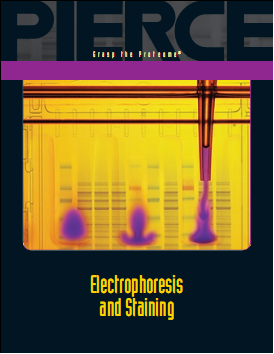|
|
Main » 2009 » September » 16 » Electrophoresis and stainning
11:46 AM Electrophoresis and stainning |

Gel Electrophoresis of ProteinsGel electrophoresis is a technique in which charged molecules, such as protein or DNA, are separated according to physical properties as they are forced through a gel by an electrical current. Proteins are commonly separated using polyacrylamide gel electrophoresis (PAGE) to characterize individual proteins in a complex sample or to examine multiple proteins within a single sample. PAGE can be used as a preparative tool to obtain a pure protein sample, or as an analytical tool to provide information on the mass, charge, purity or presence of a protein. Several forms of PAGE exist and can provide different types of information about the protein(s). • Nondenaturing PAGE, also called native PAGE, separates proteins according to their mass:charge ratio • SDS-PAGE, the most widely used electrophoresis technique, separates proteins primarily by mass • Two-dimensional PAGE (2-D PAGE) separates proteins by isoelectric point in the first dimension and by mass in the second dimension  Prepare the gelHomemade Gel RecipesAcrylamide is the material of choice for preparing electrophoretic gels to separate proteins by size. Acrylamide mixed with bisacrylamide forms a cross-linked polymer network when the polymerizing agent, ammonium persulfate, is added (Figure 1). The ammonium persulfate produces free radicals faster in the presence of TEMED (N,N,N,N′-tetramethylenediamine). The size of the pores created in the gel is inversely related to the amount of acrylamide used. For example, a 7% polyacrylamide gel will have larger pores in the gel than a 12% polyacrylamide gel. Gels with a low percentage of acrylamide are typically used to resolve large proteins and gels with a high percentage of acrylamide are used to resolve small proteins. Table 1 provides recipes for preparing gels with different acrylamide concentrations. Pierce offers many of the raw materials necessary for preparing PAGE gels, all of which are supplied with minimal contaminants. For example, Pierce SDS (Product # 28312) is a high-grade material, containing at least 98% of the C12 alkyl sulfate chain length, with minimal presence of C14 or C16 chain length. This results in more consistent SDS-PAGE separations and improved renaturation of proteins for in situ enzyme activity.1 Full PDF |
|
Views: 858 |
Added by: anis
| Rating: 0.0/0 |
|
| Our poll |
|---|
|
| Statistics |
|---|
Total online: 1 Guests: 1 Users: 0 |
|

